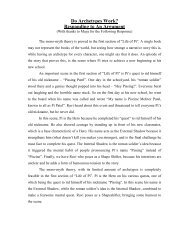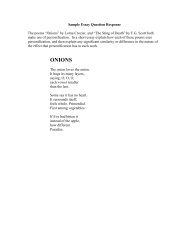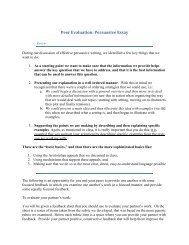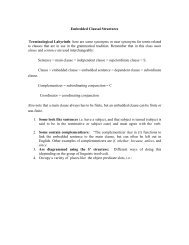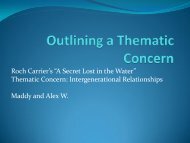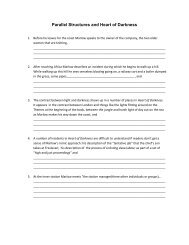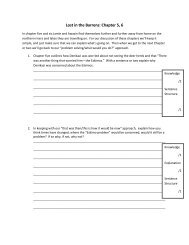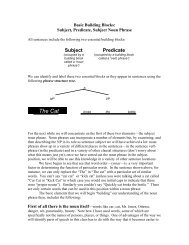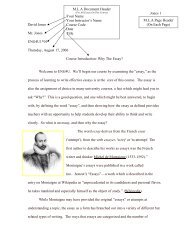The Pose By: Anwer Khan - with david jones
The Pose By: Anwer Khan - with david jones
The Pose By: Anwer Khan - with david jones
Create successful ePaper yourself
Turn your PDF publications into a flip-book with our unique Google optimized e-Paper software.
OUTLINING A THEMATIC CONCERNExample: <strong>The</strong> <strong>Pose</strong> by <strong>Anwer</strong> <strong>Khan</strong><strong>The</strong>matic Concern: Modern and Traditional Knowledge
THEME<strong>The</strong> relationship between traditional and modern knowledge isapparent in the text, “<strong>The</strong> <strong>Pose</strong>.”i. <strong>The</strong> story outlines a story of how a young female from Indiairrationally decides to pose as a mannequin.ii.iii.<strong>The</strong>n refers to how the protagonist (young woman) feelsabout strangers’ new perspective of herself.Concludes <strong>with</strong> an altered viewpoint of how difficult it is tobalance her traditional (family honor) and the modern (collegestudent) outlooks.
P.O.V- THE POSEi. <strong>The</strong> point of view in this text is the 3rd person limited omniscient.ii.iii.iv.This means the story is told by an outside narrator that knows andunderstands thoughts and feelings of the protagonist.Example: “She was happy… No one had looked at her so appreciativelybefore.”P.O.V. can read her thoughts, meaning it shows her feeling powerful (e.g.“receiving the adulation of her subjects”).v. Towards the end, tone shifts to feeling powerless (e.g. “family's honorexposed so shamelessly”).
LITERARY DEVICES“<strong>The</strong> <strong>Pose</strong>” uses many literary devices such as similes andpersonification to add depth to the two viewpoints of theprotagonist.• Simile“Like a kind and caring queen receiving the adulation of her subjects.”• Personification“His eyes seemed to say: Incredible!”
SIMILEExample; “Like a kind and caring queen receiving the adulation of her subjects.”i. Protagonist feels dominantii.This observation is unusual because women are not usually authoritative inIndia, making it a newer outlook on life.iii. This quote demonstrates the modern aspect of the theme of this story.
PERSONIFICATIONExample “His eyes seemed to say: Incredible!”i. <strong>The</strong> cop is objectifying the main characterii.This quote is reflecting the old-fashioned sexist view of how women are seenin traditional Indian households.iii. This quote demonstrates the traditional aspect of the theme of this story.
THE SINGING SILENCE<strong>By</strong> Yvano and Zoe
LITERARY DEVICES• Pov: 1 st & 3 rd person• <strong>The</strong> story is told from the narrators point of view which would signify the aspect of 1 st person.• Example: “Old Vicente of Formentera was perhaps the happiest man I’ve ever known.”• It is also told in 3 rd person, because there are parts where the narrator retells the situation in the eyes of anobserver.• Example: “Vicente knew that he would never have the money to buy an amphora, but whatwas to prevent his finding one?”• Allegory was presented in this story. “Vicente has the search. It is not what one finds, it’s the search.”• <strong>The</strong> Conflict in “<strong>The</strong> Singing Silence” is firstly the constant life changes for Vicente, then secondly, theaccident <strong>with</strong> the broken Amphora, and lastly, the unsuccessful search and the African wind storm.• Through the story we think Vicente will go out at sea and find the Amphora and send it off to the nice americantraveller. Though, at the end, this so called nice traveller, turns out to have given Vicente a fake address, andVicente who went looking for another Amphora, unexpectedly was lost out at sea by the African storm. <strong>The</strong>sewere unexpected events thrown in at the end of the story, leaving the reader in ‘awe’.
THEME: TRADITIONAL VS. MODERNKNOWLEDGE• <strong>The</strong>re were two types of knowledge that were displayed in this story, traditionaland modern. Traditional pertains to an older, more classic morality and modernpertains to a more contemporary way of morality.• We can look to the character of Vicente for an example of traditional knowledge,and the character of the American “Mr. Abraham Lincoln Smith” as anexample of the contrary.• Vicente promises to find another Amphora• He keeps this promise, and does everything in his power to retrieve the objectthat he has promised to replace.• <strong>The</strong> American showed a sense of modern knowledge by lying.• He gave Vicente a fake address because he felt annoyed by his persistence toreplace the vase.
VICENTE: TRADITIONAL KNOWLEDGE• Vicente is an old man who by accident broke an ancient vase called an Amphora.He immediately felt bad about the situation and promised to find another one. <strong>By</strong>finding another Amphora, it requires the old man to go out to sea and swim deepdown in search for an ancient object. This shows traditional knowledge because itdisplays a highly regarded sense of honour, pride and gratitude that Vicentepossess.• Vicente being an older man will see these traits as tradition and will carryout themin the highest respect whereas the American see them as choice of action whichsets the difference between the two.
COMPARING THE TWO TEXTS
STYLISTIC DIFFERENCES• Two works: “<strong>The</strong> <strong>Pose</strong>”, and “Singing Silence.”• <strong>The</strong>me: traditional and modern knowledge.• 3 rd person vs. 1 st person P.O.V.s
POINT OF VIEW: 3 RD PERSON VERSUS 1 STPERSON• “<strong>The</strong> <strong>Pose</strong>” uses 3 rd person omniscient limited P.O.V., while “Singing Silence” uses 1 stperson.• In “<strong>The</strong> <strong>Pose</strong>”, a 3 rd person P.O.V. that can see into the protagonist’s feelings is used tocommunicate the theme of modern and traditional knowledge through her own thoughtsand experiences – like realizing she enjoys being admired until faced <strong>with</strong> her traditionalfamily honor.• In “Singing Silence”, a 1 st person point of view is used to tell a story from an outsider’spoint of view. This P.O.V. is used to get the theme across by telling the differences inVicente’s demeanor from a bystander’s perspective.• Though the two show a character changing and reconsidering traditional and modernvalues, one peers into their mind, and one is told from the outside.
CONFLICT:• “<strong>The</strong> <strong>Pose</strong>” and “Singing Silence” are both examples of person versus self as well asperson versus society.• P Vs. Self• Both have self conflict, balancing modern versus traditional views. (“Singing Silence'sVicente deciding he should quit his job, “<strong>The</strong> <strong>Pose</strong>” protagonist suddenly deciding to takea risk)• “<strong>The</strong> <strong>Pose</strong>” is P Vs. Society because her outlook on her values are heavily impacted byher traditional family. For example; “What if [her brother] saw [her]… Wouldn’t he dropdead?”• “Singing Silence” is P Vs. Society as Vicente struggles <strong>with</strong> fitting as he changesoccupations and moves around a lot, as unapproving bystanders call him ‘loco, estehombre, a little crazy.”
WHAT DO THESE DIFFERENCES ADD UP TO?• <strong>The</strong> narration in “Singing Silence” is far less personal than that of “<strong>The</strong> <strong>Pose</strong>”.• In “Singing Silence”, two people represent the theme of traditional vs modern knowledge,Vicente and Mr. Abraham Lincoln Smith, while in “<strong>The</strong> <strong>Pose</strong>”, the female protagonistrepresents both viewpoints.• It seems as though in “<strong>The</strong> <strong>Pose</strong>”, the two viewpoints are developed through someone’sthoughts, instead of it being soley represented in “Singing Silence”.• Both end <strong>with</strong> the same moral: it is difficult to balance the two viewpoints.



